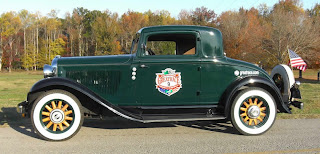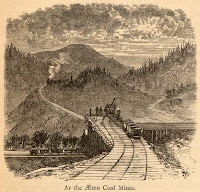A few weeks ago I became aware that the Hot Rod Power Tour was going to be in Chattanooga on Thursday, June 6th. This is a rally of sorts sponsored by Hot Rod Magazine. It moves from city to city over a one week period, usually going to cities with car-related attractions. This year it was to start in Arlington, Texas, and proceed through Texarkana and Little Rock, AR, then to Memphis and Birmingham, and finally through Chattanooga to North Concord, NC. The main attraction for me was that typically, the event draws a couple thousand participants in high-quality hot rods. This year was no exception. The Web site indicated 2,600 projected entries.
I decided it might be fun to drive my 1932 Plymouth coupe to Chattanooga and back in one day. It's about 125 miles to Chattanooga State Community College, the advertised venue where the cars would arrive. I researched a possible route on which I wouldn't have to get on the interstate. It turns out that there are several no-interstate options. I finally decided to take Highway 431 south to Highway 72, then proceed east as far as New Hope/South Pittsburgh, TN. Just before I might normally get on Interstate 24, I would opt for Tennessee highway 156 leading to Tennessee highway 134. This connects with Georgia route 299 connecting with US highway 11 into Chattanooga. The longest leg, on US highway 72, is about 70 miles. This is a divided 4-lane road, which makes it easy for other motorists to go past my car, which is only capable of 55-60 miles per hour.
 |
| The "Back Roads" Route |
 |
| Winston, ready for the trip |
As the day approached, I asked my friend Clint Rankin if he would like to join me. He drives an older Land Rover that is technologically in the same league as my Plymouth. His family resided for many years in the region along the Tennessee River through which we would be travelling. Clint agreed to go with me. I prepared the car, greasing the chassis, changing oil and filter, checking all the lights, and topping off the fuel. We were as ready as we'd ever be. I mentioned the trip to Monty Love and he said that he and his son Patrick would like to join us. They could be our escort vehicle. Everything was in place for a boys' day out!
I started watching the weather about ten days in advance of our trip. It didn't look good. I don't like to drive the Plymouth in the rain unnecessarily because it only has one very ineffective windshield wiper. Unless someone has driven a car with vacuum-operated wipers (typically pre-1955) they can't appreciate how bad they were. Whenever you give the car more gas, i.e., try to accelerate, the windshield wipers slow down or stop! Try going up a hill. You have no wipers. Downhil, they go like crazy -- vwap, vwap, vwap, vwap! You get the picture -- I didn't want to drive the old car if rain was likely.
The day before departure, the weatherman was predicting 60% likelihood of rain. I decided to abandon the idea of driving "Winston" and to drive my truck instead. At about the same time, I heard from Monty that he and Patrick would be unable to go. So now, it would be Clint and me in my truck, but I still wanted to take the back roads to scout out the route for future adventures.
Clint and I met on highway 72 and got underway at around 7:00 AM. We stopped in Scottsboro, AL, and had breakfast at the Huddle House. Then we proceeded on our preplanned route. As we reached the haven of Whiteside, Tennessee, on highway 134, Clint was describing his ancestors who had lived in this community and mentioned that many are buried in the Mt. Aetna cemetery (Clint pronounces it "Mount Etny" in the way he has heard it from his kinfolks.). He pointed out the road that goes to the top of Mt. Aetna, and we did what any red-blooded boys would do -- we headed up the mountain.
 |
One of the better-preserved tombstones
at the Aetna Cemetery, Lizzie Graham,
who died in 1890 |
After leaving the highway, we proceeded through a one-lane railroad underpass and soon ran out of pavement. The gravel road winds up a steep incline marked by multiple switchbacks. This was all punctuated by various points of interest descriptions. "That house belonged to my great aunt. It was sealed up after she died and still has all her belongings in it." "There's where old Mrs. so-and-so lived. My cousin walked up the mountain every winter day to start her fire for her." After what seemed like a long time, we arrived at a flat spot at the top of the mountain, and there beheld the Aetna Cemetery in which many of Clint's ancestors are interred. It clearly is not cared for or visited very often. It was completely overgrown. I was surprised at the expanse of the place. It covers several acres.
In the late 19th century, this mountain was an active coal mining site. There are layers of coal below the top of the mountain. According to the Nooga.com blogsite, "In 1839, land grants from the state of Tennessee passed ownership of parts of Raccoon Mountain to James A. Whiteside and F.W. Lea. Whiteside joined with Robert Craven
 |
A 19th-Century etching of
Aetna Mountain mining |
to form the East Tennessee Iron Manufacturing Company in 1852. Aetna Mountain was found to contain a rich vein of coal, and the Aetna Coal Company was formed and began operations there in 1855.
Coal mining on Aetna Mountain grew. The coal company built a railroad across the mountain, and inclines were built to haul coal to the bottom of the mountain. Houses were built on and around the mountain, and the Aetna Mountain/Whiteside Mountain School was established. A cemetery on the Marion County section of Aetna Mountain reveals the lives that were led on or near the mountain in the mid-1800s."
We took a few pictures and returned down the mountain, proceeding into Chattanooga and to the Coker Tire Company on Chestnut Street.
 |
| Coker Tire Company Headquarters |
Clint's cousin, Jess Hodenpyle, works at Coker. Also, my friend Jeff Stumb, who is from Huntsville, now works for Corky Coker as the Director of the Great Race, now owned by Coker. We paid a visit to both of them, looked around the Coker site at preparations for the evening's Hot Rod-related festivities, and moved on to the campus of the Chattanooga State Community College.
 |
| A sample of the thousands of cars at CSCC |
This was the perfect site for such a huge event. It's a commuter college, so there are parking lots everywhere. We walked for seemingly miles among thousands of cars that had been driven from Birmingham that day. The quality and variety of cars was overwhelming. My particular interest is traditional hot rods as they might have been built in the late 1950's when I graduated from high school. These typically would be modified cars of the thirties powered by souped up engines no newer than around 1955. There were a few scattered among the participants, but the muscle cars of the '60's and '70's prevailed.
After a couple of hours of gawking, Clint and I headed home along an alternative back road route. We even went within a few hundred yards of his grandfather's home near Guild, Tennessee. We arrived home tired but having enjoyed a great day out -- and we only had a few drops of rain!















